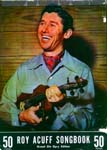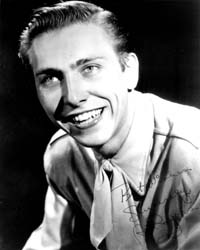



|
 |
|||||||||||||||||||||||
|
About The Artist
His father must have noticed his son's musical talents and interest. When Al was twelve, his father purchased a used guitar at a local pawn shop. That guitar was a Christmas present to Al. It didn't take long for Al to master; he learned to play it quickly, with very little instruction. In a 1947 article, we learn that he formed his first band when he was just 12 years old. The boys would entertain the local folks with their young country music sounds at various community events as well as occasionally at theatres and parks.
Al's professional career in Country Music began at that time; with his rather driving his to and from his weekend gigs. By the time he was sixteen, he already had his own successful radio show, along with his sister, Millie, who sang and played Bass on Station WKPA in New Kensington. During World War II, Al enlisted in the U. S. Air Force and was assigned to Special Services and entertained the troops in the South Pacific, the Philippines and Okinawa. After his discharge in 1946, he auditioned and was given a daily radio show on WJAS in Pittsburgh, Pennsylvania, playing his guitar and singing. His high ratings attracted a top sponsor from St. Louis, Missouri, Groves Laboratories. As a matter of fact, Al's ratings were higher than Arthur Godfrey, who followed Al on the station with his CBS Show. A member of his fan club, Mildred Stinner, wrote Floy Case to let her know that Al's shows over WJAS were on each morning at 7:15am.
Another columnist, Mary Jean Shurtz, wrote in one of articles of how she got to meet Al back in 1946. It perhaps shows you how the media and the artists were back then, a bit more like family and friend, getting together informally when the chance arose. Mary Jean had told Chaw Mank, a fan club president like no other, that she was traveling around to meet a few of the acts in the Ohio and Pennsylvania area. Chaw told his cousin in Pittsburgh to make sure Al Rogers was there when she arrived. Indeed he was as well as the female singer on his shows at the time, Betty Pearl. Mary Jean noted that they had a grand time, talking most of the night and well, Al probably had to rush to make it to the WJAS studios in time to make his early morning show. We can perhaps fast forward to the new century and note, that perhaps the internet and email has replaced those informal gatherings between artist and journalist / writer.
She tells us of Al's experience in Amarillo prior to coming to WJAS. He seemed to have clicked with the listeners on KGNC. His fan mail set a record in terms of the coverage it was coming from. Fans as far away as 10,000 miles were writing him at the station. The listeners began to know him as "The American Folk Balladeer". She gives us further details of his radio schedule - the 7:15am show was six mornings a week. On Mondays, Wednesdays and Fridays, he was on the air at 11:30am as well. Chaw Mank wrote in a 1947 article that one of Al's sponsors on the show was Groves Laboratories. Al would entertain his listening audience with not only his singing, but according to Ms. Shurtz, he knew how to do recitations in the form of poetry on his shows as well. She closed her article by telling fans, "He's big time material and doesn't need any finishing touches."
After he left Pittsburgh, he moved east to radio station WSAZ in Huntington, West Virginia. He wrote one of the magazine columnists in 1948 that he had just appeared on Nelson King's WCKY Jamboree. Ms. Shurtz noted that Al's show at WSAZ , the Western Hayride, was no small affair - it included a troupe of 22 entertainers! They were known for doing personal appearances at many of the large county fairs back in that area - Adams County, Highland County as well as the major "Tobacco Fairs" back then. One of his sponsors over WSAZ was Gwinn Brothers Flour Mills. While in Huntington, his radio shows aired each day Monday through Saturday at 6:45am and 1:00pm and on Saturdays, he also appeared at noon.
Some of the other entertainers Al was going to share the stage with were Bobby Cook and the Texas Saddle Pals; Al Hendershot and his Dixie Ramblers; the armless musician, Ray R. Myers; Fred and Ollie Cook and their Skyline Patrol; Jimmie Skinner; Ray Lunsford and others. One article notes that the dog, three months training and transportation to and from Morristown, New Jersey where the dogs were raised and trained cost over $150 back then. Another article notes that the matinee performance that day was opened by none other than Hawkshaw Hawkins.
While playing in a band at a high school prom, he net his future wife, Betty Ross, of Munhall, Pennsylvania. After a year of courtship, they were married on May 20, 1947. We should also point out that Betty also shared the stage with her husband at times using the stage name of Betty Pearl. Al organized his first band, and they all hit the road together, headed for Huntington, West Virginia. Post-war bookings were sparse, but Al managed to do his own bookings and promotions. At that time, he also had an early morning radio show with is band at WHTN in Huntington, West Virginia, Kentucky and Southern Ohio. Al's determination, and above all, his hunger for success, kept him booking schools, ball parks, fairs and theaters, or anything else that was available, but the years of struggle with the band proved to be too much, and he decided to go it alone. Along about 1949 or so, Al was the stage manager for a country music venue, Hillside Park. Betty Pearl was a part of his act at that time and one columnist noted that she hadn't seen Al do his comedy routine yet, though had heard good reviews about his efforts. Around this time, we read where Al and his group were touring in a new Chrysler Town and Country automobile.
The columnists seem to learn the most personal of details. We learned in one column that Betty Pearl had her tonsils removed in 1949. In 1949, Mary Jean Shurtz wrote in the Buddy Starcher fan club newsletter that Al was touring on behalf of the International Harvester company through March of 1949. Betty was a part of the troupe as well, playing bass. The show was based out of Louisville, Kentucky and took them throughout Kentucky, Ohio and Indiana. She noted that Al had signed a recording contract with a record label but she may have had the label name incorrect at that time. While at WAVE, Al decided to try his luck at getting a recording contract. He went to Nashville and auditioned for Fred Rose of Acuff-Rose Publications. This was what he termed the break of his lifetime. Al auditioned for Fred and after singing only a few lines of a song, Fred stopped him and said, "I'll have you a contract within thirty days". Two days later, Al got a telephone call from Fred Rose telling him that he was now an MGM Recording Artist.
Among his popular recordings on MGM were, "Forever Isn't Long Enough To Love You", "Deep Water", "Gee But It's Loneomse Out Tonight", "It Wouldn't Be the Same Without You". His records were well received according to Billboard Magazine and the "Disc Jockey Pick" charts. Several of his recordings were on the hit charts at WWVA in Wheeling, West Virginia, WJJD in Chicago, Illinois, WPAT is Patterson, New Jersey, and WVOK in Birmingham, Alabama, as well as other cities across the nation.
Al's second career break came when J. L. Frank, one of the all time great managers of country music artists asked if he would like to join the radio station WSM's famous Grand Ole Opry in Nashville, Tennessee. "You bet I would", Al said. Like many country music stars of that era, he had dreamed of being on the Opry; Al was one of the few to realize that ambition. He commuted from Louisville to Nashville every Saturday night to appear in front of the Grand Ole Opry audiences at the Ryman Auditorium. He kept his radio and television shows on WAVE in Louisville, Kentucky. Al tells us that Lew Childre was the person who first introduced him on stage at the Ryman Auditorium to the Opry audience.
Other Radio and Television Shows followed at KGNC in Amarillo, Texas, WOAI in San Antonio, Texas and KVOA in Tucson, Arizona. In 1950, Country Song Roundup featured Al in one article, picking him as a "Star for 1950". Al and Betty decided to settle in Amarillo in 1950. In 1952 their first daughter, Joanne (Jodi), was born. In 1957, their second daughter, Kathy, was born. For the next thirty years Amarillo was home for the Rogers family. During those years he had a very popular TV series that he produced and starred in, called The Panhandle Barn Dance". The Amarillo audiences seem to adopt Al as one of their own native sons; the longevity of his show is testament to that as well as his ability to feature the famous acts of the day when they came through Amarillo such as Roger Miller, Brenda Lee, Little Jimmy Dickens and others.
Country Song Roundup also reported in 1952 that he had been named one of the top Western band leaders by the Orchestra World magazine. He also owned his own night club with the same name, where he and his band entertained a full house of fans each night. Years later, he opened another club in Amarillo called the Sipango Club where he performed as a solo artist, and was still very popular. In March of 1984, the Board of Directors of the Country Music Foundation elected Al to the Country Music Hall of Fame Walkway of Stars. The installation ceremony was held on June 15, 1984. Today Al lives with his wife Betty by the beautiful sea at Rockport, Texas, a quiet and peaceful community where he writes and records in his own studio. Weekends you'll find him playing and singing at the Key Allegro Yacht Club, overlooking beautiful Aransas Bay. Credits & Sources
|
| Printer Friendly Version |
|
Recordings (78rpm/45rpm)
| |||||||||||||||||||||||||||||||||||||||||||||||||||||||||||||||||||||||||||||
Hillbilly-Music.com
Yes, Hillbilly Music. You may perhaps wonder why. You may even snicker. But trust us, soon your feet will start tappin' and before you know it, you'll be comin' back for more...Hillbilly Music.
Hillbilly-music.com ...
It's about the people, the music, the history.
|
Copyright © 2000—2023 Hillbilly-Music.com
|
||||